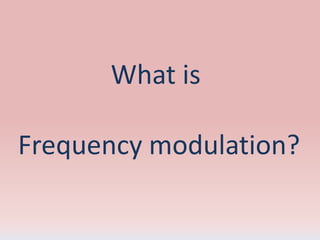
Introduction to fm modulation
- 2. Frequency modulation uses the information signal, Vm(t) to vary the carrier frequency within some small range about its original value
- 3. Here are the three signals in mathematical form: Information: Vm(t) Carrier: Vc(t) = Vco sin ( 2 p fc t + f ) FM: VFM (t) = Vco sin (2 p [fc + (Df/Vmo) Vm (t) ] t + f)
- 4. We have replaced the carrier frequency term, with a timevarying frequency. We have also introduced a new term: Df, the peak frequency deviation. In this form, you should be able to see that the carrier frequency term: fc + (Df/Vmo) Vm (t) now varies between the extremes of fc - Df and fc + Df.
- 5. The interpretation of Df becomes clear: it is the farthest away from the original frequency that the FM signal can be. Sometimes it is referred to as the "swing" in the frequency.
- 6. We can also define a modulation index for FM, analogous to AM: = f/fm where fm is the maximum modulating frequency used.
- 7. The simplest interpretation of the modulation index, b, is as a measure of the peak frequency deviation, Df. In other words, b represents a way to express the peak deviation frequency as a multiple of the maximum modulating frequency, fm, i.e. Df = b fm.
- 8. Example: suppose in FM radio that the audio signal to be transmitted ranges from 20 to 15,000 Hz (it does). If the FM system used a maximum modulating index, b, of 5.0, then the frequency would "swing" by a maximum of 5 x 15 kHz = 75 kHz above and below the carrier frequency.
- 9. Here is a simple FM signal:
- 10. Here, the carrier is at 30 Hz, and the modulating frequency is 5 Hz. The modulation index is about 3, making the peak frequency deviation about 15 Hz. That means the frequency will vary somewhere between 15 and 45 Hz. How fast the cycle is completed is a function of the modulating frequency.
- 11. A spectrum represents the relative amounts of different frequency components in any signal. Its like the display on the graphicequalizer in your stereo which has leds showing the relative amounts of bass, midrange and treble. These correspond directly to increasing frequencies (treble being the high frequency components). It is a well-know fact of mathematics, that any function (signal) can be decomposed into purely sinusoidal components (with a few pathological exceptions)
- 12. In technical terms, the sines and cosines form a complete set of functions, also known as a basis in the infinite-dimensional vector space of real-valued functions (gag reflex). Given that any signal can be thought to be made up of sinusoidal signals, the spectrum then represents the "recipe card" of how to make the signal from sinusoids.
- 13. Like: 1 part of 50 Hz and 2 parts of 200 Hz. Pure sinusoids have the simplest spectrum of all, just one component: In this example, the carrier has 8 Hz and so the spectrum has a single component with value 1.0 at 8 Hz
- 14. The FM spectrum is considerably more complicated. The spectrum of a simple FM signal looks like:
- 15. The carrier is now 65 Hz, the modulating signal is a pure 5 Hz tone, and the modulation index is 2. What we see are multiple side-bands (spikes at other than the carrier frequency) separated by the modulating frequency, 5 Hz. There are roughly 3 side-bands on either side of the carrier.
- 16. The shape of the spectrum may be explained using a simple heterodyne argument: when you mix the three frequencies (fc, fm and Df) together you get the sum and difference frequencies. The largest combination is fc + fm + Df, and the smallest is fc - fm - Df. Since Df = b fm, the frequency varies (b + 1) fm above and below the carrier.
- 17. A more realistic example is to use an audio spectrum to provide the modulation:
- 18. In this example, the information signal varies between 1 and 11 Hz. The carrier is at 65 Hz and the modulation index is 2. The individual side-band spikes are replaced by a more-or-less continuous spectrum. However, the extent of the side-bands is limited (approximately) to (b + 1) fm above and below. Here, that would be 33 Hz above and below, making the bandwidth about 66 Hz. We see the side-bands extend from 35 to 90 Hz, so out observed bandwidth is 65 Hz.
- 19. You may have wondered why we ignored the smooth humps at the extreme ends of the spectrum. The truth is that they are in fact a by-product of frequency modulation (there is no random noise in this example). However, they may be safely ignored because they are have only a minute fraction of the total power. In practice, the random noise would obscure them anyway.
